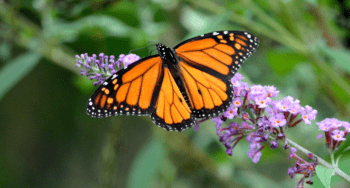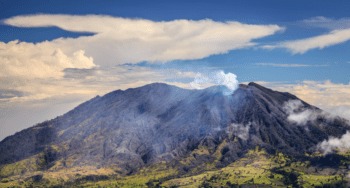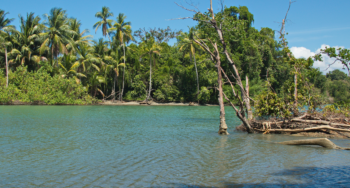Monteverde Wildlife Guide: What's Covered
Monteverde’s cloud forest hosts over 400 bird species, 100 mammal species, and 161 reptiles and amphibians across seven distinct life zones. The 26,000-acre Monteverde Cloud Forest Reserve sits at 4,662 feet elevation where constant cloud cover creates unique conditions for rare species like resplendent quetzals, sloths, and howler monkeys. Driving yourself means you can start early for dawn wildlife viewing, explore multiple reserves in one day, and join night walks without coordinating shuttle schedules back to your accommodation.
Quick Facts:
- Biodiversity Density: 400+ bird species, 100+ mammals, 161 reptiles/amphibians in compact area; found in only 1% of global forests
- Best Viewing Season: December-April dry season for easier spotting with fewer leaves; breeding season February-April peaks activity
- Continental Divide Impact: Pacific side drier/windier with smaller vegetation, Caribbean side rainier with thicker growth
- Night Tours Essential: Sloths, wildcats, tree frogs, kinkajous active after dark; completely different species than daytime viewing
- Seven Life Zones: From lower montane to upper cloud forest, each with distinct flora and fauna within small geographic area
Top Wildlife Experiences:
- Resplendent Quetzal Spotting – Emerald-green bird with crimson belly most visible December-April, especially breeding season February-April; look in Monteverde Cloud Forest Reserve, Sky Adventures, and Curi-Cancha Reserve near avocado trees at dawn
- Two-Toed Sloth Encounters – Sleep 15 hours daily and are nocturnal, so night tours offer best action viewing; slow-moving with curved claws, descend trees only every 1-2 weeks
- Howler Monkey Troops – Deep guttural calls echo through forest announcing territory; 15-22 lbs primates rarely leave canopy except during dry spells searching for water
- White-Faced Capuchins – Troops of 20 monkeys with alpha male, females, babies; skilled tool users that hunt cooperatively, named for monk-like markings
- Night Walk Wildlife – Wildcats (ocelot, margay, oncilla, puma, jaguar), tree frogs, poison dart frogs, cane toads, bioluminescent insects, coatis become active after sunset
- Blue Morpho Butterflies – Vibrant iridescent blue wings flutter through forest; crucial pollinators contributing to ecosystem balance
- Toucan Species – Keel-billed (rainbow beak, yellow chest), Emerald Toucanet (smaller), Black-Mandibled (rarer with yellow bill) spotted throughout reserves
- Hummingbird Diversity – 20 species including Purple-Crowned Woodnymph, Fiery-Throated, Violet Sabrewing, Stripe-Tailed; jewel-colored birds at feeders throughout area
Cloud Forest vs Rainforest: Cloud forests sit at higher elevations (0.5-1.5 miles) with constant cloud cover creating cooler temps, greater moisture, shorter twisted trees covered in moss. Rainforests exist at lower altitudes with taller straight trees, higher temperatures, and different species concentrations. Both vulnerable to climate change requiring conservation efforts.
Wildlife Tour Options: Guided birdwatching tours for quetzals and toucans, canopy ziplines for aerial perspective, suspension bridge walks above forest floor, customizable private tours combining day and night experiences. Multiple reserves include Monteverde Cloud Forest Reserve, Children’s Eternal Rainforest (56,000 acres), Santa Elena Reserve, Curi-Cancha, plus specialized spots like Frog Pond, Orchid Garden, and San Luis Waterfall.
Sustainable Practices: Use reusable water bottles, stay on designated trails, avoid flash photography and loud noises near wildlife, support local conservation initiatives, choose eco-friendly accommodations. Learn more about planning your Monteverde visit and getting around the area. Having your own vehicle lets you arrive at reserves for dawn wildlife activity and explore multiple outdoor activities across different locations in a single day.
If you need any help with a Costa Rica car rental, contact us now!
Monteverde’s Biodiversity: A Brief Overview
Monteverde is renowned for its lush cloud forest, which contributes to its rich biodiversity and is a rare environment which is only found in 1% of the global forest coverage. The region is home to over 400 species of birds, making it a bird watcher’s paradise. The canopy of the cloud forest also supports 100 diverse species of mammals, and 161 species of reptiles, and amphibians. With its unique climate and ecosystem, Monteverde offers visitors a chance to witness a remarkable variety of animal life.The Unique Ecosystem of Monteverde
Monteverde’s cloud forest creates a unique ecosystemt is characterized by a nearly constant cover of clouds, which provides the perfect conditions for a host of plants and animals to thrive. The lush vegetation, including epiphytes, orchids, and mosses, creates a magical ambiance for visitors to enjoy as they explore the trails through the trees. trails. The cloud forest also acts as a natural water source, contributing to the region’s rich biodiversity and creating a habitat for numerous species of birds, mammals, reptiles, and amphibians. Monteverde’s ecosystem is divided into seven different life zones which each has its own distinct flora and fauna. From the lower montane forest to the upper cloud forest, visitors can witness the incredible diversity of plants and animals that have adapted to these unique environments. There are 12 life zones across the country as a whole so this opportunity to explore many of them in one place makes Monteverde a must-visit destination for nature enthusiasts and those seeking a deeper connection with the natural world.The Continental Divide
The lush landscapes of the Pacific side are drier and windier whereas the Caribbean side is rainier and more humid, therefore forest growth is noticeably different. The Caribbean side has thicker, larger vegetation due to the more intense moisture whereas the Pacific side has less cloud cover and smaller vegetation as a result.The Role of Monteverde in the Conservation Efforts
Monteverde plays a crucial role in conservation efforts, with the Monteverde Cloud Forest Reserve and private reserves leading the way in preserving the region’s unique biodiversity. These reserves are dedicated to protecting the delicate ecosystems of Monteverde and providing habitats for endangered species. Conservation efforts in Monteverde focus on sustainable practices, including reforestation, wildlife research, and education programs for local communities and visitors. By supporting these initiatives, visitors contribute to the long-term preservation of Monteverde’s diverse wildlife and help ensure future generations can continue to enjoy its natural wonders.Wildlife Packages: Experience Monteverde’s Flora and Fauna
Immerse yourself in the wonders of Monteverde’s flora and fauna with the diverse range of wildlife packages available. These packages offer nature enthusiasts the opportunity to explore the unique ecosystems of Monteverde up close and personal. Whether you’re interested in birdwatching, canopy tours, zip lines, or suspension bridges, there’s a wildlife package that caters to your specific interests.Popular Wildlife Packages in Monteverde
- Bird enthusiasts can embark on guided birdwatching tours to spot the vibrant bird species of Monteverde, including the resplendent quetzal, hummingbirds, and toucans.
- Ziplines provide an exhilarating experience as you zip from platform to platform, taking in the breathtaking views of the cloud forest below.
- Suspension bridges offer a leisurely stroll high above the forest floor, giving you the opportunity to observe diverse animal species.
- Guided or non-guided cloud forest tours through the various reserves in Monteverde to view wildlife day or night.
Customizable Wildlife Packages in Monteverde
For those seeking a more personalized wildlife experience, Monteverde offers customizable wildlife packages. These packages allow you to tailor your adventure based on your specific interests and preferences. There are many reserves which can offer private guided tours which can meet the individual needs of a group and can build a combination of tours such as day and night options. Whether you want to focus on birdwatching, exploring the lush vegetation, or observing different species of mammals, Monteverde’s customizable wildlife packages ensure a truly unique and unforgettable experience. Work with local guides and experts to create an itinerary that matches your wildlife dreams, and get ready to embark on a journey of discovery in the diverse ecosystems of Monteverde, Costa Rica.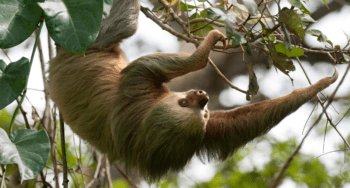
Wildlife Spotlight: Iconic Species of Monteverde
Monteverde is home to several iconic species that captivate the hearts of visitors. From the leisurely two-toed sloth, the voice of the howler monkey, and the fluttering spectacle of the blue morpho butterfly, these species represent the unique biodiversity of Monteverde and are a delight to encounter during your exploration of the cloud forest.Two-toed Sloth: An Emblem of Pura Vida
When you think of Costa Rica, one of the first animals that comes to mind is likely the adorable two-toed sloth. This emblematic symbol of the country’s laid-back Pura Vidaifestyle can often be spotted lazily hanging from tree branches in Monteverde. These cute creatures sleep up to 15 hours a day and are nocturnal so for your best chance of seeing them in action; consider a night tour! Its slow movement and unique adaptations, such as its long, curved claws, enable it to maneuver effortlessly through the forest canopy, feasting on leaves and only descending to the forest floor every one or two weeks.. Keep your eyes peeled as you explore the cloud forest, and you may be lucky enough to witness these fascinating creatures in their natural habitat.Howler Monkey: The Voice of the Jungle
The howler monkey, Monteverde’s iconic primate, is known as the voice of the jungle. With its deep, guttural howls echoing through the forest, the howler monkey announces its presence and establishes its territory. These monkeys rarely leave the forest canopy unless a dry spell brings them to the ground to search for water. The large primates weigh between 15 and 22 lbs and are 2-3 feet in height. . Keep your ears tuned for their distinctive calls, and follow the sound to witness these lively creatures in action as they leap from tree to tree with incredible agility.White-Faced Monkey: The Playful Primate
This species of monkey is found across most of Central America but they have been in decline due to deforestation and habitat loss. On average the monkeys are 1-2 feet in height and weigh 2-8 lbs. The troops consist of about 20 monkeys including an alpha male, females and babies with young adult males moving outside the extended family group. The monkeys are also known as Capuchins as the markings on their fur resemble the robes worn by monks. They are skilled at using tools and can work as a team to tackle larger prey.Blue Morpho Butterfly: A Fluttering Spectacle
One of the most enchanting sights in Monteverde is the fluttering spectacle of the blue morpho butterfly. With its vibrant, iridescent blue wings, this species captivates all who are lucky enough to encounter it. The blue morpho butterfly is not only a stunning visual delight, but it also plays a crucial role in pollination, contributing to the ecosystem of Monteverde.Other Cloud Forest Fauna: Incredible Diversity
The Jaguarundi is the only wildcat which is not nocturnal which means that visitors have more opportunities to see this slightly strange looking short-legged cat. This wildcat likes to live near water as they eat fish and frogs as well as small mammals.Monteverde Bird Life
There are 400 avian species found in Monteverde ranging from the tiny jewels Although visitors can expect to awake to a harmonious chorus of birdsong and will certainly spot a huge variety of , consider a guided tour for a better chance of seeing shyer or rarer birds.Resplendent Quetzal: The Gem of the Cloud Forest
One of the most sought after bird sightings is the Resplendent Quetzal which was revered by the ancient Mayans. These incredible birds inhabit cloud forest at elevation between 5,000 and 9,000 feet where their food source grows. They are most often spotted in Monteverde Cloud Forest Reserve, Sky Adventures Monteverde Park and Curi-Cancha Reserve in the Dry Season from December to April and especially during their breeding season between February and April. Other tips:- Learn the Quetzal’s distinctive call
- Identify the small avocado trees which are the Quetzal’s main food source
- Look for the birds early in the morning after dawn
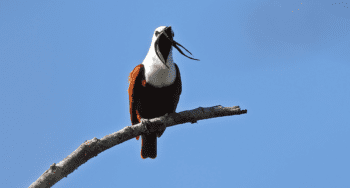
Other Cloud Forest Birds: The Feathered Wonders of Monteverde
The male Three-Wattled Bellbird stands out for the long wattles hanging from their beaks and their loud, bell-like calls, hence the name! Listen out for their distinctive call to spot the iconic birds in the canopy but be aware that the dark green and yellow female is completely different to the striking black and white plumaged male.The Bellbird inhabits the geography between Honduras and Panama. Visitors to Monteverde often have toucans high on their list of birds to see and the cloud forest is home to several species. The most common is the Keel-Billed Toucan with its trademark large rainbow beak and bright yellow chest in contrast to its otherwise black plumage. The smaller Emerald Toucanet is also often seen but the Black-Mandibled Toucan with its bright yellow bill and chest is a rarer sight. The Black-Breasted Wood Quail lives in groups of 15-20 birds in the thick undergrowth of Monteverde’s forests but fly into the treetops to roost at night. As they’re noisy, they’re easy to spot! Motmots are close cousins to the kingfisher and like them, motmots dive through the air from branches to hunt their small prey. These squat birds show flashes of bright colors from their glistening feathers. Tiny, jewel-colored hummingbirds are a firm favorite for bird spotters and 20 different species have been seen in Monteverde including the Purple-Crowned Woodnymph, Fiery-Throated Hummingbird, Violet Sabrewing and Stripe-Tailed Hummingbird. Sociable Oropendolas live close together and many will make their distinctive hanging nests in the same tree. The Chestnut-Headed Oropendola has a clear resonant call which makes them stand out from the crested Oropendola which makes a harsher sound. Look out for the Scarlet-Rumped Cacique too whose bright red tail feathers can be seen as they fly through the forest. Noisy Parrot species draw attention to themselves with their loud cries as they fly over the forest in pairs at dusk and dawn. Visitors to Monteverde may be rewarded with glimpses of Scarlet and Green Macaws, Olive-Throated parakeet, Orange-Chinned Parakeet, Brown-Hooded Parrot and Blue-Headed Parrot as well as smaller related varieties. Little woodcreepers climb along branches to search for food but blend in with their surroundings due to their brown, black and white plumage. In contrast, the different species of tanagers display flashes of color to make them stand out from the green foliage. Tiny wrens are very common in the cloud forest and delight hikers with their charming birdsong. Visitors may also spot vultures, sparrows, falcons, flycatchers, finches and many other types of birds.Monteverde Night Walk: A Different Perspective
Exploring Monteverde’s cloud forest during the day is an incredible experience, but to truly appreciate its full diversity, a night walk is a must. During this unique adventure, you’ll have the opportunity to encounter the nocturnal species that come to life under the cover of darkness. From bioluminescent insects lighting up the forest to tree frogs, toads, kinkajous, coatis, and the elusive ocelot, the night walk offers a different perspective on the vibrant ecosystems of Monteverde.What to Expect during a Monteverde Night Walk
During a Monteverde night walk, you can expect to witness nature in a different light. As the sun sets, the forest transforms, and the nocturnal creatures awaken. The cloud cover often adds an extra layer of mystery to create a unique atmosphere that enhances your experience.Fascinating Nocturnal Species of Monteverde
The cloud forest of Monteverde is home to a fascinating array of nocturnal species. From spiders and insects to reptiles and mammals, these creatures have adapted to thrive in the darkness of the forest. It’s a chance to witness their intricate hunting and foraging techniques, as well as gain a deeper understanding of their role in maintaining the balance of the ecosystem.Wildcats
The cloud forest is home to the five species of wildcat found in Costa Rica, but they are rarely seen and four are nocturnal. The arboreal ocelot is distinguished by its large paws which led to Costa Ricans naming it Manigordo or “fat hand.” Only lucky visitors will see the margay which is arboreal and nocturnal. The oncilla is also known as the northern tiger cat, resembles a large house cat and lives on birds and rats. These small cats weigh just 2-6 lbs. and as there has not been much research into them, their habits remain mostly unknown. Pumas or mountain lions can adapt to a broad range of environments including the colder climes of the cloud forest and are quite regularly seen on camera traps. They can grow to almost 8 feet in length and weigh up to 220 lbs.The jaguar is the largest of the wildcats as they are over 6 feet long and weigh over 500 lbs. on average. As they cover vast territories, loss of their habitat has made them vulnerable.Frogs and Toads
From tiny tree frogs and poison dart frogs to the cane toad which is the largest toad found worldwide, visitors can expect to see a wide variety of these amphibians in Monteverde … .if they just go looking for them.Monteverde Wildlife Throughout the Seasons
To make the most of your wildlife experience in Monteverde, it’s important to consider the best time to visit. The dry season, from December to April, offers optimal conditions for wildlife sightings, as there are fewer leaves on the trees so animals are easier to spot. To witness unique animal behaviors, such as breeding season rituals or migratory patterns, timing your visit accordingly can provide a deeper understanding of the diverse wildlife of Monteverde.Best Time to Visit Monteverde for Wildlife
The best time to visit Monteverde for wildlife viewing is during the dry season, which runs from December to April. This is when animal activity is at its peak, as the dry conditions make it easier to spot wildlife amidst the leafless trees. Additionally, the breeding season of many species occurs during this time, offering a unique opportunity to witness fascinating animal behaviors. Bird enthusiasts, in particular, should plan their visit during the dry season, as it is the prime time for spotting a variety of bird species in Monteverde. From colorful toucans to majestic raptors, the cloud forest comes alive with the vibrant plumage and melodic calls of these feathered inhabitants. Whether you’re an avid birder or simply appreciate the beauty of avian life, the dry season promises exceptional bird watching experiences in Monteverde.Seasonal Wildlife Behavior in Monteverde
Monteverde’s diverse wildlife exhibits unique behaviors throughout the seasons, offering visitors a chance to witness the natural rhythms of life in the cloud forest. Different species of birds, for example, showcase a range of behaviors depending on the time of year. From courtship displays to nest building and feeding their young, observing these seasonal behaviors provides invaluable insights into the lives of Monteverde’s avian residents. The breeding season, which varies among species, is a particularly fascinating time to visit. During this time, male birds often engage in elaborate displays of plumage and song, competing for the attention of females. Nesting activities and the feeding of chicks offer another glimpse into the intricate lives of Monteverde’s bird species. Whether you’re an avid birder or simply fascinated by the wonders of nature, observing seasonal wildlife behavior in Monteverde is a captivating experience that deepens your connection to the natural world.Monteverde Cloud Forest Reserve
At the heart of Monteverde’s conservation efforts is the Monteverde Cloud Forest Reserve. Established in 1972 by the Tropical Science Center, this reserve encompasses over 26,000 acres of protected land, allowing visitors to explore and appreciate the marvels of the cloud forest. The reserve’s main objective is to preserve the unique ecosystem of Monteverde, including its diverse flora and fauna. By visiting the Monteverde Cloud Forest Reserve, you directly support the conservation efforts in place and contribute to the future of this incredible destination. Funding for The Children’s Eternal Rainforest started in the 1980s when Swedish school students started to collect money to protect the forest and the initiative grew to motivate fundraisers from 44 different countries. It is now the largest private reserve in Costa Rica and covers more than 56,000 acres.What is a cloud forest?
A cloud forest is a unique type of tropical forest characterized by its rich biodiversity, lush vegetation, and a nearly constant cover of clouds. Found in four continents worldwide, cloud forest is found between 0.5 to 1.5 miles above sea level The cloud cover in these forests contributes to the maintenance of moisture, creating a high level of humidity, which allows epiphytes, mosses, and other unique plant species to grow abundantly. This rich vegetation, in turn, supports a variety of animal life, including numerous bird species, mammals, reptiles, amphibians, and insects. Cloud forests, like the one in Monteverde, are crucial for climate change mitigation, as they provide habitat for diverse animal species and contribute to the overall health of our planet.What is the difference between a cloud forest and a rainforest?
While cloud forests and rainforests share similarities, they have distinct characteristics that set them apart. Both ecosystems are found in tropical regions and boast incredible biodiversity. However, cloud forests have unique species of mammals, birds, reptiles, amphibians, and plants that differ from those found in rainforests. The key difference between the two lies in climate and altitude. Cloud forests, like Monteverde, are typically situated at higher elevations, where the cloud cover plays a crucial role in creating unique environmental conditions. The cloud cover results in cooler temperatures, greater moisture, and more mist, which contributes to the lush vegetation and diverse animal life found in cloud forests. Rainforests, on the other hand, are located at sea level or lower altitudes. They typically experience higher temperatures, abundant rainfall, and a different range of plants and animals compared to cloud forests. Trees are taller and straighter in rain forests whereas they tend to be shorter and more twisted in cloud forest. The boughs and branches of the cloud forest are covered in moss due to the heavy year long precipitation in this environment.Both cloud forests and rainforests are vulnerable to climate change, making their conservation efforts crucial for preserving their unique ecosystems. Monteverde Frog Pond: This pond is dedicated to conserving and showcasing the diverse frog species in the region. Guided tours provide insights into the unique characteristics of these amphibians San Luis Waterfall and Cloud Forest: Located a bit outside Monteverde, this area is less crowded but offers a chance to see various bird species, monkeys, and the stunning San Luis Waterfall. Monteverde Orchid Garden: While primarily known for its orchids, this garden is also home to various hummingbirds and butterflies. It’s a delightful spot for nature enthusiasts.